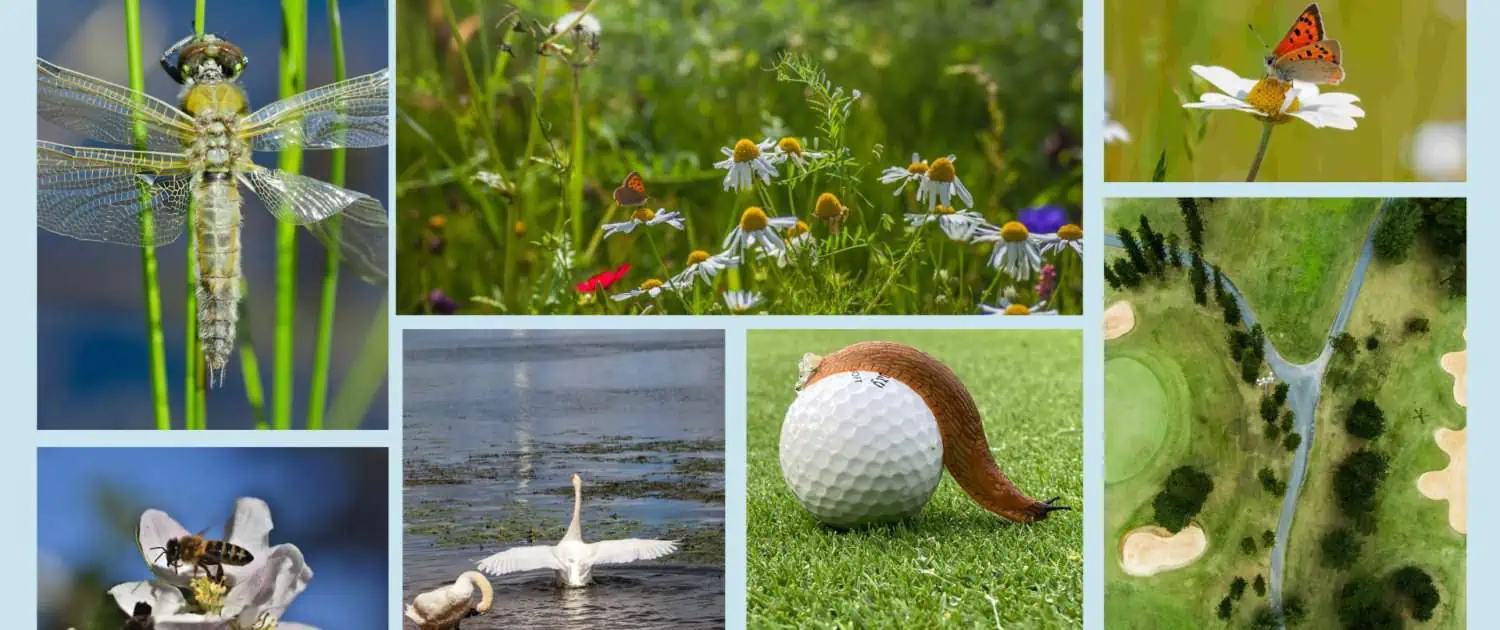The biodiversity lexicon: Everything about species diversity
The biodiversity lexicon provides a general as well as sport and golf-specific overview of the most important terms relating to biodiversity. The most important aspects are explained here, from definitions and relevance for humans to international and national agreements, strategies and projects and sport- and golf-specific species protection programs, current studies, sources of information and authorities, with links to each.
Definition, scope and geographical classification
Biodiversity is generally divided into three interrelated areas that influence each other. The diversity of species, habitats and genetic diversity within the individual plant and animal species are summarized for this purpose. A total of around 1.8 million species worldwide are thought to have been scientifically described. Experts estimate a total of 15 million species on earth.
While the 25 species-rich areas, such as in the tropics, only account for a very small proportion of the earth’s surface (1.4 percent), the proportion of species living in these areas is disproportionately high. 44 percent of all plant species and a third of all vertebrate species are found here. With around 3,000 vascular plant species, Germany is a relatively species-poor country compared to plant-rich countries such as Brazil (56,000 plant species).
Ongoing species extinction: Causes and indicators
The overexploitation of nature with deforestation and colonization is largely responsible for the decline in biodiversity, as are the species introduced by humans and climate change.
According to a 2019 report by the World Biodiversity Council (IPBES ), a total of 680 vertebrate species have gone extinct since 1500. The Red List of the International Union for Conservation of Nature (IUCN) states that over 35,500 species are currently threatened with extinction. According to the IUCN, 33 percent of all marine fish stocks are considered overfished. The Forest Report of the Food and Agriculture Organization of the United Nations (FAO ) assumes that ten million hectares of forest will die every year between 2015 and 2020. In the context of the exponential increase in species extinction, the IPBES warns that one million species worldwide are threatened with extinction, many of them within the next few decades.
Relevance and impact on human life
Only if there is a wide genetic range within a species is there a chance that organisms are present that can adapt to new conditions. Otherwise there is a high risk that it will die out.
The loss of biodiversity can endanger civilization; the diversity of nature is the basis of human life and global economic development. Diseases and pests in crops for food production can trigger major crises. According to IPBES, the loss of pollinators also leads to horrendous financial damage, which is estimated to be between 235 and 588 billion US dollars for crop producers each year. In its Global Risk Report 2024, the World Economic Forum ‘s Global Risk Report ranked biodiversity loss and ecosystem collapse as the third biggest global risk in a ten-year forecast.
International and continental agreements and programs
The international agreement CITES (Convention on International Trade in Endangered Species of Wild Fauna and Flora) is intended to ensure between the governments involved that international trade in specimens of wild animals and plants does not endanger the survival of the species. It relates to fauna and flora in the three areas of legality, sustainability and traceability. The adoption of the Kunming-Montreal Global Biodiversity Framework (GBF) in December 2022 at the Conference of the Parties to the Convention on Biological Diversity (CBD) will have a direct impact on nature conservation policy.
At European level, the European Union’s “Green Deal” also sets out the political framework with its Biodiversity Strategy 2030, which includes the expansion of Natura 2000 areas and a legislative proposal to introduce an EU law on nature restoration with binding targets.
National strategies in Germany
The National Strategy on Biological Diversity (NBS) is the most important instrument in Germany for implementing international and European commitments to the protection and sustainable use of biological diversity. According to a draft by the Federal Ministry for the Environment, Nature Conservation, Nuclear Safety and Consumer Protection (BMUV) from June 2023, it is to replace the last version from 2007 with a new version in 2030. A cabinet decision on the NBS 2030 supported by the federal government is planned for 2024 and is linked to an action plan.
The Federal Agency for Nature Conservation (BfN), which is part of the BMUV division, also publishes nature awareness studies every two years. In 2021, social awareness of biodiversity was also examined here by comparing the previous and new monitoring instruments of the national biodiversity strategy since 2009 according to sociographic characteristics.
(Golf) sport and biodiversity
In the field of sport in general, there are numerous organizations that work with sports associations. In its new play book published in December, the EU Green Sports Expert Group Report presents recommendations for member states and sports organizations for environmentally friendly sport as part of the development of national sustainable sports strategies or the creation of a carbon footprint for sports associations.
Throughout Europe and in Asia, the international non-profit organization GEO Foundation for Sustainable Golf is heavily involved in biodiversity issues in golf. It advises associations and clubs in Austria, Switzerland, the UK and Arab countries and provides important information for golf course operators. The World Wide Fund For Nature (WWF) works particularly closely with golf associations in France, Switzerland and England. The common aim of all these collaborations is to fully exploit the potential for promoting biodiversity on the unplayed areas of golf courses. As one of the two central institutions in global golf, the R&A also makes important contributions to the area of biodiversity as part of its Golf Course 2030 (GC2030) project.
In Germany, the BMUV’s 3rd position paper “Sustainable Sport 2030“, which was relaunched in September 2023, the Nature Conservation-Nature Sports Information System, the Sport & Nature program of the Olympic Sports Confederation (DOSB) and the Board of Trustees for Sport and Nature are important programs in the field of sport in general. For golf in particular, there are programs both at national level (BfN’s Federal Biological Diversity Program, “GolfBiodivers”) and at regional level(Blühpakt Bayern, “Habitat Golf Course – We promote biodiversity”). In addition, there are also associations such as the Landesbund für Vogelschutz (LBV) in the federal state of Bavaria, which implement joint projects with golf associations.








